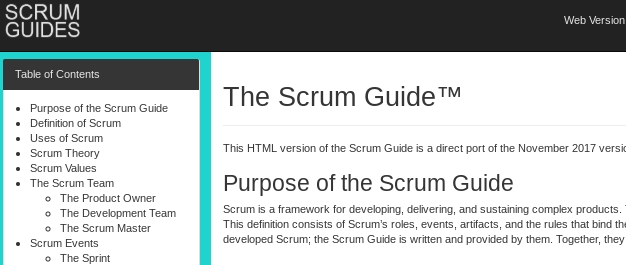As a developer, you’re often charged with tackling complex projects. Organizing, prioritizing, and delegating tasks is a necessary but often challenging aspect of project management.
The Scrum Methodology is a simple concept that can be used to streamline these types of complex projects. Implementing the Scrum Framework can help you facilitate greater collaboration and productivity. The result is better-quality products delivered in less time.
In this post, we’ll discuss what the Scrum Methodology is and explain the benefits of using it. Then we’ll provide you with six steps you can follow for using this framework to accelerate your team’s productivity. Let’s get into it!
An Introduction to the Scrum Methodology
The Scrum Methodology is a framework of agile software development. It’s used to enhance teamwork and collaboration on complex projects.
To understand the philosophy behind Scrum, it’s helpful to consider its origin. ‘Scrum’ is a rugby term that refers to a formation in which each player has a particular role. However, every member works together to achieve the same goal.
Since the nineties, the Scrum Methodology has been used as a project management tool in agile software development. Agile development doesn’t offer concrete steps for executing a project or strategy. Rather, it’s more of a mindset. It stems from the Agile Manifesto, and values self-organization and collaboration above all else.
Scrum is one of the multiple frameworks that can be used in agile software development projects, as well as other industries tasked with creating products. It’s lightweight and easy to understand, if not quite as simple to master. Scrum doesn’t tell you how to do things, only what needs to be done.
How to Use the Scrum Methodology to Boost Your Team’s Productivity (In 6 Steps)
Taking the Scrum approach to project management lets development teams prioritize their work and streamline operations. Let’s take a look at the six steps you can follow to apply this methodology, in order to improve your own team’s productivity and performance.
Step 1: Familiarize Yourself With Scrum Guides
The first thing you should do before adopting the Scrum Methodology is to gain an understanding of its essential elements and events. There is an abundance of materials online that offer guidance on the Scrum framework. We recommend starting with the official Scrum Guide:

This comprehensive guide can be downloaded as a PDF, or you can bookmark the web version to reference as needed. It was created by the originators of the Scrum Methodology: Ken Schwaber and Jeff Sutherland.
Once you understand the basics of the Scrum Guide, you will be better prepared to apply the framework to your own development projects. It will also help you make sense of the next steps in the process.
Step 2: Assign Roles to Your Scrum Team
To implement the Scrum Methodology, you need to form a ‘Scrum Team’. This will consist of:
- A Product Owner. This person is a stakeholder, who facilitates communication and priorities among the development team. They are responsible for maximizing the value of the product and essentially serve as the customer representative or proxy.
- The Scrum Master. The Scrum Master makes sure the Development Team remains creative and productive, acting as a liaison between the team and the Product Owner. They do not, however, manage the team.
- The Development Team. The Development Team is typically made up of around seven people and includes a mix of engineers, programmers, testers, and UI designers. Each individual is self-managed and in charge of determining how to complete the work that they’re given.
When choosing these roles, it’s important to remember the specific function and duties involved. For example, the Product Owner must be someone who feels confident speaking on behalf of the customers’ best interests.
Step 3: Create a Product Backlog
Put simply, the Product Backlog is an ongoing list of the work that needs to be done. This document outlines every requirement, feature, and function needed for a product or other project.
The items included in this list are ordered by the Product Owner in terms of importance and business value. As the project develops and new requirements or fixes are revealed, the Backlog is updated.
Having a clear vision at this stage of the implementation process is crucial. To create a visual hierarchy, it’s helpful to develop a Scrum Board. You can use a project management tool such as Trello to do this:

Trello is free to use, and lets Scrum Teams keep organized on critical tasks. The Product Owner, whether that’s you or someone else, can assign tasks for each Backlog item. The task cards can then be pulled by developers to use for their Sprint planning (which we’ll get to next).
Step 4: Conduct Sprint Planning and Daily Standup Meetings
Once you get your Backlog created, it’s time for Sprint Planning. This involves the Development Team taking the highest-priority items and figuring out how to achieve them.
An important part of this stage is establishing how much time will be needed to complete each objective. Usually, the duration of a Sprint is anywhere between two and four weeks.
The Sprint Planning should be kept relatively brief, as most of the work should be focused on completing the chosen objectives for that Sprint. It’s the Scrum Master’s responsibility to ensure that these time-boxed events are kept to a minimum.
For example, let’s say your team is given a Sprint duration of three weeks. At the start of each week, no more than two hours should be spent planning out how your objectives will be achieved.
It’s a good idea to schedule brief daily ‘standup’ meetings with your Scrum team as well. These should be no more than 15 minutes, and serve as a way to stay updated on each member’s progress and tasks.
Step 5: Define When a Sprint Is Considered Done
The Scrum Master is responsible for making sure everyone on the Scrum Team is on the same page about what it means to be done with a Sprint. Sprints are only complete when the product or project is ready to be delivered or reviewed by the stakeholders.
This means that it has completely passed the quality check, and there is no need for additional edits or reviews. The criteria for a Backlog item to be considered done varies from one development team to the next. However, what matters is that the expectations are clearly communicated to all team members.
Step 6: Review, Reflect, and Repeat
At the end of every Sprint, you’ll want to schedule a Sprint Review meeting with your team. This event will be an opportunity for your team to present or demonstrate their completed work.
In this review, the Product Owner should evaluate the work against the predetermined ‘done’ criteria. The stakeholders can offer feedback, and decide to accept or deny the work. The review stage is also a good time for the Product Owner to revisit the Backlog, in order to prepare for the next Sprint Planning session.
Next comes the Sprint Retrospective meeting. This is where your team and the Scrum Master will reflect on the Sprint, to discuss and document what did and didn’t work. In these meetings, it’s helpful to focus less on what went wrong and more on which areas could be improved for the next time.
Once the Sprint Review is done, it’s time to start again. Your team can take what they learned from the previous Sprint, and use it to improve their processes for the next Backlog item.
Conclusion
Managing complex development projects can be time-consuming and overwhelming. To maximize the productivity of your team, you need a framework that reduces cycle time and costs.
As we discussed in this article, there are six steps involved in the Scrum Methodology:
- Familiarize yourself with the Scrum Guide, to gain a comprehensive understanding of its key processes and elements.
- Assign roles to the Scrum Master, Product Owner, and Development Team.
- Create a Product Backlog, using a project management platform such as Trello.
- Conduct Sprint Planning meetings to establish clear goals and objectives.
- Make sure all team members are clear about what it means for a Backlog item to be complete.
- Review after each Sprint to reflect on what did and didn’t work, and then repeat the cycle.
Do you have any questions about using the Scrum Methodology? Let us know in the comments section below!
Image credit: Pexels.
The post How to Use the Scrum Methodology to Boost Your Team’s Productivity (In 6 Steps) appeared first on Torque.
